1. Introduction
 Kingmax was founded in 1989 and since then has been providing quality storage solutions and products. Kingmax rose to the ranks of the world's top five memory module producers in 2003, according to iSuppli.com. Kingmax has now split into "Kingmax Semiconductors Division" which produces RAM modules for desktop PCs and Notebooks and "Kingmax Digital Division" which produces Flash memory products. If you need further information about Kingmax, you can always read Mr. Lawrence Chang's interview, Kingmax's VP of Sales & Marketing.
Kingmax was founded in 1989 and since then has been providing quality storage solutions and products. Kingmax rose to the ranks of the world's top five memory module producers in 2003, according to iSuppli.com. Kingmax has now split into "Kingmax Semiconductors Division" which produces RAM modules for desktop PCs and Notebooks and "Kingmax Digital Division" which produces Flash memory products. If you need further information about Kingmax, you can always read Mr. Lawrence Chang's interview, Kingmax's VP of Sales & Marketing.
In this review we will put the Kingmax DDR-400 modules to the test. We received 2x512MB memory modules, tested to work in Dual Channel mode.



Kingmax uses their own chipset for these memory modules, promising good performance when operating in Dual Channel mode. These RAMs are part of the SuperRAM series, but they are not the fastest SuperRAM modules Kingmax has to offer. The memory clock is set to 400MHz, but there are also modules clocked at 433MHz available on the market. You can see the full SuperRAM product series here.

The modules use 16 chipsets. Each chipset handles 32MB of memory. For those trying to make out the small printing on the label, the model number is MPXC22D-38KT3R.

- Specifications
Kingmax's chipsets offer double-data-rate architecture (two data transfers per clock cycle), bi-directional data strobe (DQS), differential clock inputs (CK and /CK), auto & self refresh capability, programmable read latency (2, 2.5 clock), programmable burst length (2, 4, 8), programmable burst type (Sequential & Interleave), edge aligned data output and center aligned data input.
Below you can see the table with the full specifications for the Kingmax DDR-400 modules.
| Product Name |
SuperRAM DDR-400 |
Part Number
|
MPXC22D-38KT3R |
| Package |
1024MB kit (2x512MB) (dual rank) |
CAS Latency
|
2-2-2-5 / 2.5-3-3-7 |
| Test Voltage |
2.5 V |
| Speed |
DDR 400 MHz (PC3200) |
| Type |
184-pin DDR SDRAM |
| Error Checking |
Non-ECC |
| Registered/Unbuffered |
Unbuffered |
2. Test Configuration & System
After installing the two memory modules, we checked with the BIOS utility and with CPU-Z to see the SPD Timings. The memory uses two SPD timings. When the frequency clock is set to 400MHz, the memory will go with 2.5-3-3-7 timings, but if you choose to reduce the frequency clock to 266MHz (cannot see why someone want to) you will have 2-2-2-5 timings.

Of course, in this review, we will be testing the Kingmax DDR-400 modules operating at 400MHz (200MHz - Dual Channel).

For these tests we used an AMD Athlon 64 3500+ CPU (Newcastle), running at 2200MHz.

In this review, we will be comparing the Kingmax DDR-400 with the Corsair XMS TwinX 1024-3200XL and Apacer Real500 Ram Modules. Below you can see the SPD Timing for these memory modules, according to CPU-Z.
- Corsair XMS TwinX 1024-3200XL

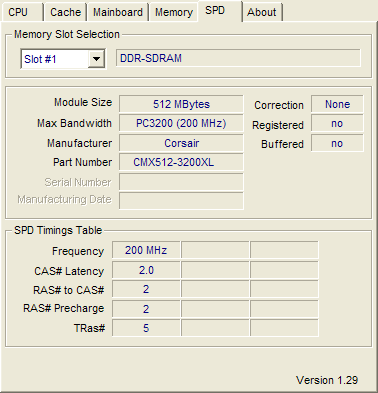
- Apacer Real500

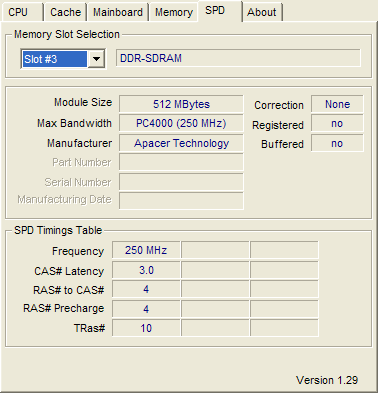
Here's a rundown of our testbed:
System Specifications
CPU: AMD Athlon 64 3500+ CPU (Newcastle)
Case: Antec
Motherboard: ASUS A8N-SLI Deluxe
Power supply: CoolerMaster 450W
Memory: Kingmax SuperRAM DDR-400 PC3200 (2x512MB)
VGA: ASUS 6800GT PCI-E
Hard Disk Drive: WD800JD 80GB 7200RPM
OS: Windows XP Pro SP2
Drivers: 7.7.7.7
DirectX: v9.0c

Benchmarks & Applications used
- Memtest86+-1.60
- Sisoft Sandra 2005
- PcMark05
- Performance Test V5.0 ( PassMark)
- Half Life 2 - VST
- CPU-Z v1.29
3. SiSoft Sandra 2005
 SiSoftware Sandra is a 32 and 64-bit Windows system analyser that includes benchmarking, testing and listing modules. It tries to go beyond other utilities to show you more of what is really going on under the hood so you draw comparisons at both a high and low-level in a single product.
SiSoftware Sandra is a 32 and 64-bit Windows system analyser that includes benchmarking, testing and listing modules. It tries to go beyond other utilities to show you more of what is really going on under the hood so you draw comparisons at both a high and low-level in a single product.
You can get information about the CPU, chipset, video adapter, ports, printers, sound card, memory, network, Windows internals, AGP, ODBC Connections, USB2, Firewire etc.
You can save/print/fax/e-mail/post/upload or insert into ADO/ODBC databases reports in text, HTML, XML, SMS/DMI or RPT format.
This version supports multiple sources of information gathering including: remote computers, PDAs, Smart Phones, ADO/ODBC databases or saved system reports.
All benchmarks are optimised for both SMP & SMT (Hyper-Threading), up to 32/64 CPUs depending on the platform.
Memory Bandwidth Benchmark
Tests how your memory sub-system compares to other systems with the same or similar memory in other systems. The benchmark is based on the well-known STREAM memory bandwidth benchmark.
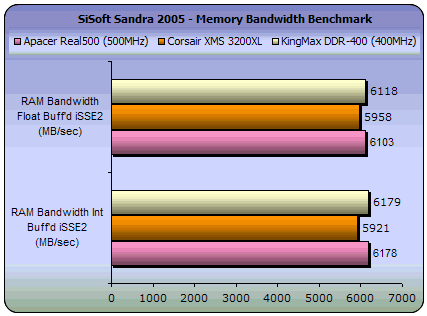
Cache & Memory Benchmark
Tests how your CPU cache and memory sub-system(s) compares to other systems with the same or similar CPU & memory in other systems. The benchmark is based on the Memory Bandwidth Benchmark test.
Combined Index: is a composite figure representing the overall performance rating of the entire Cache-Memory performance in terms of MB/s. The value is the logarithmic average of all the results for the entire address space. (Higher is better, i.e. better performance)
For block sizes that could not been tested - the average of previous blocks is used, thus the size of the memory (as long as it is not comparable to largest cache size) is not significant; all cache sizes are significant - larger caches will result in a higher index.
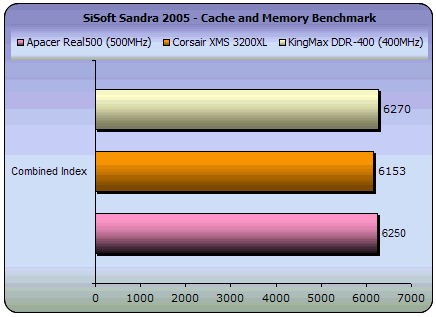
Speed Factor: is a figure representing the speed differential between the CPU’s cache and memory. The value is the ratio of the fastest cache (i.e. L1) bandwidth to the main memory bandwidth. (Lower is better, i.e. the memory is not very much slower than CPU’s cache)
As the factor is a ratio, it is useful only in comparing different CPUs and memory sub-systems rather than having a direct, physical interpretation associated to its numerical value.
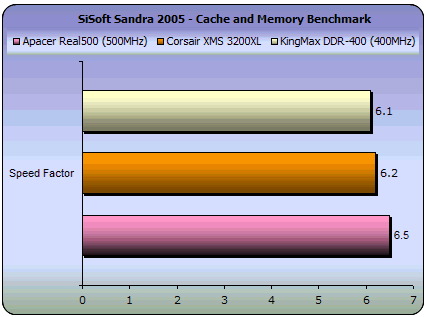
Theoretically, the Corsair memory should be the faster memory, since it operates at 400MHz with 2-2-2-5 timings, but the Kingmax memory proves this assumption is false. The Kingmax DDR-400 was the fastest memory in all SiSoft Sandra's benchmarks.
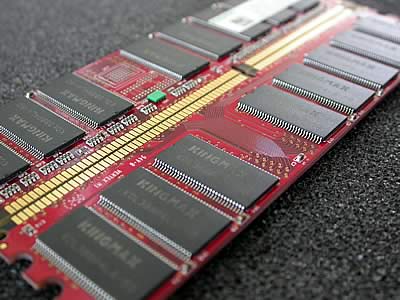
4. PCMark05
 PCMark05 is an application-based benchmark and a premium tool for measuring overall PC performance. It uses portions of real applications instead of including very large applications or using specifically created code. This allows PCMark05 to be a smaller installation as well as to report very accurate results. As far as possible, PCMark05 uses public domain applications whose source code can be freely examined by any user.
PCMark05 is an application-based benchmark and a premium tool for measuring overall PC performance. It uses portions of real applications instead of including very large applications or using specifically created code. This allows PCMark05 to be a smaller installation as well as to report very accurate results. As far as possible, PCMark05 uses public domain applications whose source code can be freely examined by any user.
PCMark05 includes 4 categorized suites for benchmarking your computer. These include CPU, Graphics, Memory and a Hard Disk Drive benchmark. In our case, we selected to run only the Memory test suite.
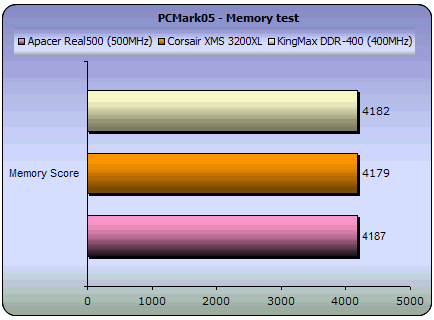
Although the Apacer REAL500 memory runs at 500MHz, it could not outperform the Kingmax memory. We should point out that Kingmax memory operates with 2.5-3-3-7 timings, which is considered to be considerably slow, compared with the Corsair and Apacer memory, but in this case, timings cannot show the whole picture.
PCMark05
Memory Test |
Apacer Real500 |
Corsair XMS TWINX1024-3200XL |
Kingmax DDR-400 |
| Memory Read 16MB |
5918.761 |
6018.050 |
6019.584 |
| Memory Read 8MB |
6042.337 |
6146.775 |
6152.459 |
| Memory Read 192KB |
10774.117 |
10808.938 |
10810.915 |
| Memory Read 4KB |
27970.318 |
28036.627 |
28064.641 |
| Memory Write 16MB |
5892.469 |
5920.201 |
5925.154 |
| Memory Write 8MB |
5880.213 |
5947.440 |
5954.144 |
| Memory Write 192KB |
7002.098 |
7027.576 |
7041.341 |
| Memory Write 4KB |
21453.559 |
21515.932 |
21524.675 |
| Memory Copy 16MB |
5681.817 |
5745.178 |
5754.159 |
| Memory Copy 8MB |
5762.229 |
5777.745 |
5779.978 |
| Memory Copy 192KB |
4406.925 |
4420.483 |
4431.456 |
| Memory Copy 4KB |
11395.134 |
11464.957 |
11469.954 |
| Memory Latency 16MB |
11.216 |
12.462 |
12.578 |
| Memory Latency 8MB |
12.462 |
14.318 |
14.597 |
| Memory Latency 192KB |
134.880 |
134.880 |
134.880 |
| Memory Latency 4KB |
734.751 |
734.751 |
734.751 |
5. Performance Test v.5
 Passmark PerformanceTest is an award winning PC hardware benchmark utility that allows everybody to quickly assess the performance of their computer and compare it to a number of standard 'baseline' computer systems.
Passmark PerformanceTest is an award winning PC hardware benchmark utility that allows everybody to quickly assess the performance of their computer and compare it to a number of standard 'baseline' computer systems.
Twenty seven standard benchmark tests are available in seven test suites plus there are five advanced testing windows for custom benchmarking. CPU Tests, 2D Graphics Tests, 3D Graphics Tests, Disk Tests, Memory Tests and CD/DVD Tests. In our case we selected the Memory suite Tests.
- Memory Benchmarks
This suite contains a number of tests that exercise the memory sub-system of the computer. (Random Access Memory- RAM)
Memory - Allocate small block
This test measures the time taken to allocate & free small zeroed memory blocks (around 100KB block size)
Memory - Cached
This test measures the time taken to read a small block of memory. The block is small enough to be held entirely in cache (if one is present)
Memory - UnCached
This test measures the time taken to read a large block of memory. The block is too large to be held in cache.
Memory - Write
This test measures the time taken to write information into memory.
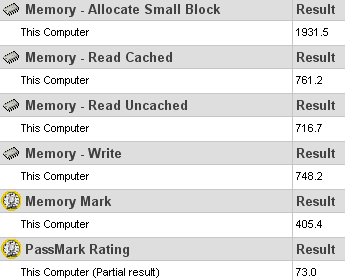
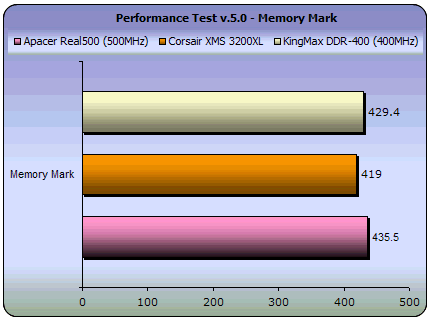
- Advanced Memory Benchmark
Memory Speed Per Access Step Size
The first test type, ‘Memory Speed Per Access Step Size’ accesses a large block, of memory in various sized steps. First, it runs through the block of memory sequentially, accessing every value. Next it runs through the same block again, except this time it accesses every second value. On this occasion, it runs through the block twice in order to access the same amount of data as the initial step. Next it runs through the same block again, except this time it accesses every fourth value and so makes four passes. And so on, until a certain maximum step size is reached.
The size of the block of memory used for this test is one quarter the amount of system RAM. The size of the steps varies from 1 (continuous sequential access), to one quarter the size of the block of memory ( i.e. one sixteenth of the system RAM ).
| Memory Speed (MB/Sec. per Step Size) |
| Apacer Real500 |
| Block Read Speed |
18.93 |
| Block Write Speed |
22.20 |
| Corsair XMS TWINX1024-3200XL |
| Block Read Speed |
20.54 |
| Block Write Speed |
23.81 |
| Kingmax DDR-400 |
| Block Read Speed |
19.96 |
| Block Write Speed |
22.83 |
Memory Speed Per Block Size
When a computer program wants to use a section of memory to store data, it makes a request to Windows for the amount of memory it requires. Windows allocates the memory to the program ( unless system resources are very low ) and returns to the requesting program the address of the first memory slot in the allocated block. It is possible that some programs may request very large amounts of memory. The ‘Memory Speed Per Block Size’ test like the ‘Memory Speed Per Access Step Size’ test, is composed of many steps. During each step of the test, PerformanceTest requests a block of memory and runs through the block measuring the average access time. However on each subsequent step the size of the requested memory is increased, until finally a block close to the size of the system RAM is requested. In this way it is possible to observe the different access speeds for the different sizes of blocks.
Typically it is possible to see very fast memory access for blocks which are small enough to fit entirely into the L2 RAM cache, and slower access times for larger blocks accessed from main RAM. In the case where system resources are low, swapping to the disk may even be required for very large blocks.
| Memory Speed (MB/Sec. per Block Size) |
| Apacer Real500 |
| Block Read Speed |
178.83 |
| Block Write Speed |
223.27 |
| Corsair XMS TWINX1024-3200XL |
| Block Read Speed |
179.43 |
| Block Write Speed |
223.90 |
| Kingmax DDR-400 |
| Block Read Speed |
181.49 |
| Block Write Speed |
229.10 |
According to Performance Test, the performance of the Kingmax SuperRAM is not the fastest as was reported by SiSoft Sandra and PCMark05. However, performance still remains at high levels and only the Apacer memory clocked at 500MHz, managed to outperform the SuperRAM memory.
6. Half Life 2 - Video Stress Test
 Half life 2 is no doubt the most anticipated pc game of all times. Gamers having the excellence of Half Life 1 in mind, as well as the remarkable E3 demo preview, have been anxiously waiting for the much delayed release of HL2.
Half life 2 is no doubt the most anticipated pc game of all times. Gamers having the excellence of Half Life 1 in mind, as well as the remarkable E3 demo preview, have been anxiously waiting for the much delayed release of HL2.
Physics - From pebbles to water to 2-ton trucks respond as expected, as they obey the laws of mass, friction, gravity, and buoyancy.
Graphics - Source's shader-based renderer, like the one used at Pixar to create movies such as Toy Story® and Monster's, Inc.®, creates the most beautiful and realistic environments ever seen in a video game.
AI - Neither friends nor enemies charge blindly into the fray. They can assess threats, navigate tricky terrain, and fashion weapons from whatever is at hand.
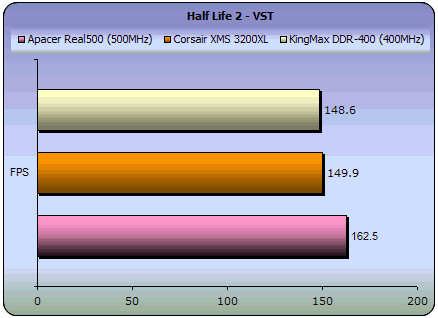
With HL2, we are trying to simulate the gaming conditions much like benchmark programs do, but we actually played the game to see the performance with the Kingmax memory. Unfortunately, the Kingmax DDR-400 proved to be the slowest of all, but no matter how disappointing this looks, memory speed still remains considerably high.
7. Overclocking
The Kingmax DDR-400 are designed to operate at 400MHz. However, programmable read latency further lets you increase the timings, but you will end up overall with slower memory, since the frequency clock is reduced to 266MHz in order to operate at 2-2-2-5 timings.

We did some overclocking tests with the SuperRAM PC3200 and we ended up with a stable system (checked with MEMTest and Prime95) running at 466MHz (2x233MHz) with 2.5-3-3-6 timings. It should be noted that we could even reach 520MHz and the system did not crash when performing the Video Stress test in HL2, but MEMTest reported several errors during the memory read process.

The overclocking potential of the Kingmax memory is very good and keep in mind, that there is no extra memory cooling provided by Kingmax. However, the memory was cool enough to touch, even when running the PCMark05 memory test. Let's see how much performance we gain while overclocking.






Although there are only small differences in performance between the 400MHz and 466MHz operating frequencies, the HL2 Video Stress test reported an 11fps boost. In all cases, the slower 266MHz setting could not compete in any way with the 400MHz and the 466MHz operating speeds. In general, the SuperRAM modules indicate very good overclocking potential, at almost the same timings as the SPD settings.

8. Conclusion
 Kingmax is one of the leading manufacturers of RAM memory modules and Flash memory products. The memory modules are not fancy with extra cooling and voltage indicators, and by the look of these modules, someone might think that the Kingmax memory cannot be a match for the other high quality, fancy looking modules. Our tests however proved that this was not the case, as the Kingmax memory modules performed just as well as anything the competition has to offer.
Kingmax is one of the leading manufacturers of RAM memory modules and Flash memory products. The memory modules are not fancy with extra cooling and voltage indicators, and by the look of these modules, someone might think that the Kingmax memory cannot be a match for the other high quality, fancy looking modules. Our tests however proved that this was not the case, as the Kingmax memory modules performed just as well as anything the competition has to offer.

Kingmax has added a lot of features in the SuperRAM series and especially the programmable read latency, which might be useful for some users who require higher timings at lower operating frequencies. There are two SPD timings offered, the default 400MHz (2.5-3-3-7) and the slower 266MHz (2-2-2-5).

In all tests, except for the HL2 Video Stress test, the Kingmax DDR-400 performed very well. In HL2, the SuperRAM DDR-400 came second in our comparison. On the other hand, overclocking potential was excellent, and the performance boost we got with HL2 was almost 11fps.

The KingMax DDR-400 modules are priced at around €55 each, which is a very good price.
The Good:
- Very good performance at 400MHz
- Cool operation
- Great features
- Very good price
The Bad:
- Slow performance at 266MHz
- Cannot operate at 400MHz with 2-2-2-5 timings